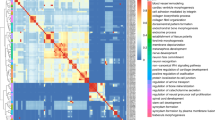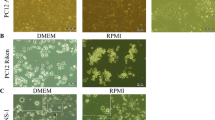Abstract
The use of dexamethasone (DEX) to prevent respiratory distress in preterm infants is suspected to produce neurobehavioral deficits. We used PC12 cells to model the effects of DEX on different stages of neuronal development, utilizing exposures from 24 h up to 11 days and concentrations from 0.01 to 10 μM, simulating subtherapeutic, therapeutic, and high-dose regimens. In undifferentiated cells, even at the lowest concentration, DEX inhibited DNA synthesis and produced a progressive deficit in the number of cells as evaluated by DNA content, whereas cell growth (evaluated by the total protein to DNA ratio) and cell viability (Trypan blue exclusion) were promoted. When cell differentiation was initiated with nerve growth factor, the simultaneous inclusion of DEX still produced a progressive deficit in cell numbers and promoted cell growth and viability while retarding the development of neuritic projections as monitored by the membrane/total protein ratio. Again, even 0.01 μM DEX was effective. We next assessed effects at mid-differentiation by introducing nerve growth factor for 4 days followed by coexposure to DEX. Although effects on cell number, growth, and neurite extension were still detectable, the outcomes were generally less notable. DEX also shifted the fate of PC12 cells away from the cholinergic phenotype and toward the adrenergic phenotype, with the maximum effect achieved at the outset of differentiation. Our results indicate that DEX directly disrupts neuronal cell replication, differentiation, and phenotype at concentrations below those required for the therapy of preterm infants, providing a mechanistic link between glucocorticoid use and neurodevelopmental sequelae.
Similar content being viewed by others
Log in or create a free account to read this content
Gain free access to this article, as well as selected content from this journal and more on nature.com
or
References
Barks JDE, Post M, Tuor UI (1991). Dexamethasone prevents hypoxic-ischemic brain damage in the neonatal rat. Pediatr Res 29: 558–563.
Bayer SA, Altman J, Russo RJ, Zhang X (1993). Timetables of neurogenesis in the human brain based on experimentally determined patterns in the rat. Neurotoxicology 14: 83–144.
Bell JM, Whitmore WL, Slotkin TA (1986). Effects of α-difluoromethylornithine, a specific irreversible inhibitor of ornithine decarboxylase, on nucleic acids and proteins in developing rat brain: critical perinatal periods for regional selectivity. Neuroscience 17: 399–407.
Berse B, Blusztajn JK (1997). Modulation of cholinergic locus expression by glucocorticoids and retinoic acid is cell-type specific. FEBS Lett 410: 175–179.
Black IB (1978). Regulation of autonomic development. Ann Rev Neurosci 1: 183–214.
Blackmon LR, Bell EF, Engle WA, Kanto WP, Martin GI, Miller CA et al (2002). Postnatal corticosteroids to treat or prevent chronic lung disease in preterm infants. Pediatrics 109: 330–338.
Bohn MC (1984). Glucocorticoid induced teratologies of the nervous system. In: Yanai J (ed). Neurobehavioral Teratology. Elsevier: Amsterdam. pp 365–387.
Bowman RE, MacLusky NJ, Sarmiento Y, Frankfurt M, Gordon M, Luine VN (2004). Sexually dimorphic effects of prenatal stress on cognition, hormonal responses, and central neurotransmitters. Endocrinology 145: 3778–3787.
Carlos RQ, Seidler FJ, Slotkin TA (1991). Fetal dexamethasone exposure sensitizes neonatal rat brain to hypoxia: effects on protein and DNA synthesis. Dev Brain Res 64: 161–166.
Charles B, Schild P, Steer P, Cartwright D, Donovan T (1993). Pharmacokinetics of dexamethasone following single-dose intravenous administration to extremely low birth weight infants. Dev Pharmacol Ther 20: 205–210.
Coe CL, Lubach GR (2005). Developmental consequences of antenatal dexamethasone treatment in nonhuman primates. Neurosci Biobehav Rev 29: 227–235.
Dean F, Yu C, Lingas RI, Matthews SG (2001). Prenatal glucocorticoid modifies hypothalamo-pituitary-adrenal regulation in prepubertal guinea pigs. Neuroendocrinology 73: 194–202.
Doyle LW, Ford GW, Davis NM, Callanan C (2000). Antenatal corticosteroid therapy and blood pressure at 14 years of age in preterm children. Clin Sci 98: 137–142.
Ebert SN, Lindley SE, Bengoechea TG, Bain D, Wong DL (1997). Adrenergic differentiation potential in PC12 cells: influence of sodium butyrate and dexamethasone. Mol Brain Res 47: 24–30.
Felszeghy K, Bagdy G, Nyakas C (2000). Blunted pituitary-adrenocortical stress response in adult rats following neonatal dexamethasone treatment. J Neuroendocrinol 12: 1014–1021.
Fujita K, Lazarovici P, Guroff G (1989). Regulation of the differentiation of PC12 pheochromocytoma cells. Environ Health Perspect 80: 127–142.
Fuxe K, Cintra A, Chadi G, Gustafsson JÅ, Agnati LF (1994). Central glucocorticoid receptors and neuronal plasticity. Methods Neurosci 22: 372–382.
Fuxe K, Diaz R, Cintra A, Bhatnagar M, Tinner B, Gustafsson JA et al (1996). On the role of glucocorticoid receptors in brain plasticity. Cell Mol Neurobiol 16: 239–258.
Ghosh B, Wood CR, Held GA, Abbott BD, Lau C (2000). Glucocorticoid receptor regulation in the rat embryo: a potential site for developmental toxicity? Toxicol Appl Pharmacol 164: 221–229.
Gilad GM, Gilad VH, Eliyayev Y, Rabey JM (1998). Developmental regulation of the brain polyamine-stress-response. Int J Dev Neurosci 16: 271–278.
Gilstrap LC, Christensen R, Clewell WH, D'Alton ME, Davidson EC, Escobedo MB et al (1995). Effect of corticosteroids for fetal maturation on perinatal outcomes. J Am Med Assoc 273: 413–418.
Gould E, Tanapat P, McEwen BS (1997). Activation of the type 2 adrenal steroid receptor can rescue granule cells from death during development. Dev Brain Res 101: 265–268.
Greenberg AK, Hu J, Basu S, Hay J, Reibman J, Yie TA et al (2002). Glucocorticoids inhibit lung cancer cell growth through both the extracellular signal-related kinase pathway and cell cycle regulators. Am J Respir Cell Mol Biol 27: 320–328.
Gross I (1990). Regulation of fetal lung maturation. Am J Physiol 259: L337–L344.
Hagerty T, Fernandez E, Lynch K, Wang SS, Morgan WW, Strong R (2001). Interaction of a glucocorticoid-responsive element with regulatory sequences in the promoter region of the mouse tyrosine hydroxylase gene. J Neurochem 78: 1379–1388.
Hu ZT, Yuri K, Ichikawa T, Kawata M (1996). Exposure of postnatal rats to glucocorticoids suppresses the development of choline acetyltransferase-immunoreactive neurons: role of adrenal steroids in the development of forebrain cholinergic neurons. J Chem Neuroanat 10: 1–10.
Ikeda T, Mishima K, Yoshikawa T, Iwasaki K, Fujiwara M, Xia YX et al (2002). Dexamethasone prevents long-lasting learning impairment following neonatal hypoxic-ischemic brain insult in rats. Behav Brain Res 136: 161–170.
Katoh S, Mitsui Y, Kitani K, Suzuki T (1997). Hyperoxia induces the differentiated neuronal phenotype of PC12 cells by producing reactive oxygen species. Biochem Biophys Res Commun 241: 347–351.
Kreider ML, Aldridge JE, Cousins MM, Oliver CA, Seidler FJ, Slotkin TA (2005a). Disruption of rat forebrain development by glucocorticoids: critical perinatal periods for effects on neural cell acquisition and on cell signaling cascades mediating noradrenergic and cholinergic neurotransmitter/neurotrophic responses. Neuropsychopharmacology 30: 1841–1855.
Kreider ML, Levin ED, Seidler FJ, Slotkin TA (2005b). Gestational dexamethasone treatment elicits sex-dependent alterations in locomotor activity, reward-based memory and hippocampal cholinergic function in adolescent and adult rats. Neuropsychopharmacology 30: 1617–1623.
Kreider ML, Tate CA, Cousins MM, Oliver CA, Seidler FJ, Slotkin TA (2006). Lasting effects of developmental dexamethasone treatment on neural cell number and size, synaptic activity and cell signaling: critical periods of vulnerability, dose-effect relationships, regional targets and sex selectivity. Neuropsychopharmacology 31: 12–35.
Lau C, Seidler FJ, Cameron AM, Navarro HA, Bell JM, Bartolome J et al (1988). Nutritional influences on adrenal chromaffin cell development: comparison with central neurons. Pediatr Res 24: 583–587.
Lucas CA, Thoenen H (1977). Selective induction by glucocorticoids of tyrosine hydroxylase in organ cultures of rat pheochromocytoma. Neuroscience 2: 1095–1101.
Maccari S, Darnaudery M, Morley-Fletcher S, Zuena AR, Cinque C, Van Reeth O (2003). Prenatal stress and long-term consequences: implications of glucocorticoid hormones. Neurosci Biobehav Rev 27: 119–127.
Matthews SG (2000). Antenatal glucocorticoids and programming of the developing CNS. Pediatr Res 47: 291–300.
Matthews SG, Owen D, Banjanin S, Andrews MH (2002). Glucocorticoids, hypothalamo-pituitary-adrenal (HPA) development, and life after birth. Endocr Res 28: 709–718.
McCollum AT, Jafarifar F, Chan R, Guttmann RP (2004). Oxidative stress inhibits ionomycin-mediated cell death in cortical neurons. J Neurosci Res 76: 104–109.
McEwen BS (1992). Steroid hormones: effect on brain development and function. Hormone Res 37: 1–10.
Meaney MJ, Diorio J, Francis D, Widdowson J, LaPlante P, Caldji C et al (1996). Early environmental regulation of forebrain glucocorticoid receptor gene expression: implications for adrenocortical responses to stress. Dev Neurosci 18: 49–72.
Muneoka K, Mikuni M, Ogawa T, Kitera K, Kamei K, Takigawa M et al (1997). Prenatal dexamethasone exposure alters brain monoamine metabolism and adrenocortical response in rat offspring. Am J Physiol 42: R1669–R1675.
Murphy BP, Inder TE, Huppi PS, Warfield S, Zientara GP, Kikinis R et al (2001). Impaired cerebral cortical gray matter growth after treatment with dexamethasone for neonatal chronic lung disease. Pediatrics 107: 217–221.
Newnham JP (2001). Is prenatal glucocorticoid administration another origin of adult disease? Clin Exp Pharmacol Physiol 28: 957–961.
Osathanondh R, Tulchinsky D, Kamali H, Fencl M, Taeusch HW (1977). Dexamethasone levels in treated pregnant women and newborn infants. J Pediatrics 90: 617–620.
Qiao D, Seidler FJ, Slotkin TA (2005). Oxidative mechanisms contributing to the developmental neurotoxicity of nicotine and chlorpyrifos. Toxicol Appl Pharmacol 206: 17–26.
Raff H (2004). Neonatal dexamethasone therapy: short- and long-term consequences. Trends Endocrinol Metab 15: 351–352.
Reznikov AG, Nosenko ND, Tarasenko LV (2004). Early postnatal effects of prenatal exposure to glucocorticoids on testosterone metabolism and biogenic monoamines in discrete neuroendocrine regions of the rat brain. Comp Biochem Physiol C 138: 169–175.
Schubert D, LaCorbiere M, Klier FG, Steinbach JH (1980). The modulation of neurotransmitter synthesis by steroid hormones and insulin. Brain Res 190: 67–79.
Seckl JR (2001). Glucocorticoid programming of the fetus: adult phenotypes and molecular mechanisms. Mol Cell Endocrinol 185: 61–71.
Seckl JR (2004). Prenatal glucocorticoids and long-term programming. Eur J Endocrinol 151: U49–U62.
Slotkin TA, Lappi SE, Tayyeb MI, Seidler FJ (1991). Dose-dependent glucocorticoid effects on noradrenergic synaptogenesis in rat brain: ontogeny of [3H]desmethylimipramine binding sites after fetal exposure to dexamethasone. Res Comm Chem Pathol Pharmacol 73: 3–19.
Slotkin TA, Persons D, Slepetis RJ, Taylor D, Bartolome J (1984). Control of nucleic acid and protein synthesis in developing brain, kidney, and heart of the neonatal rat: effects of α-difluoromethylornithine, a specific, irreversible inhibitor of ornithine decarboxylase. Teratology 30: 211–224.
Song X, Violin JD, Seidler FJ, Slotkin TA (1998). Modeling the developmental neurotoxicity of chlorpyrifos in vitro: macromolecule synthesis in PC12 cells. Toxicol Appl Pharmacol 151: 182–191.
Teng KK, Greene LA (1994). Cultured PC12 cells: a model for neuronal function and differentiation. In: Celis JE (ed). Cell Biology: A Laboratory Handbook. Academic Press: San Diego. pp 218–224.
Thai L, Galluzzo JM, McCook EC, Seidler FJ, Slotkin TA (1996). Atypical regulation of hepatic adenylyl cyclase and adrenergic receptors during a critical developmental period: agonists evoke supersensitivity accompanied by failure of receptor downregulation. Pediatr Res 39: 697–707.
Trauth JA, Seidler FJ, Slotkin TA (2000). An animal model of adolescent nicotine exposure: effects on gene expression and macromolecular constituents in rat brain regions. Brain Res 867: 29–39.
Unsicker K, Krisch B, Otten U, Thoenen H (1978). Nerve growth factor-induced fiber outgrowth from isolated rat adrenal chromaffin cells: impairment by glucocorticoids. Proc Natl Acad Sci 75: 3498–3502.
Weinstock M (2001). Alterations induced by gestational stress in brain morphology and behaviour of the offspring. Prog Neurobiol 65: 427–451.
Welberg LAM, Seckl JR (2001). Prenatal stress, glucocorticoids and the programming of the brain. J Neuroendocrinol 13: 113–128.
Winick M, Noble A (1965). Quantitative changes in DNA, RNA and protein during prenatal and postnatal growth in the rat. Dev Biol 12: 451–466.
Yeh TF, Lin YJ, Lin HC, Huang CC, Hsieh WS, Lin CH et al (2004). Outcomes at school age after postnatal dexamethasone therapy for lung disease of prematurity. N Engl J Med 350: 1304–1313.
Zahalka EA, Seidler FJ, Slotkin TA (1993). Dexamethasone treatment in utero enhances neonatal cholinergic nerve terminal development in rat brain. Res Comm Chem Pathol Pharmacol 81: 191–198.
Acknowledgements
This work was supported by NIH Grants ES10356 and ES07031.
Author information
Authors and Affiliations
Corresponding author
Rights and permissions
About this article
Cite this article
Jameson, R., Seidler, F., Qiao, D. et al. Adverse Neurodevelopmental Effects of Dexamethasone Modeled in PC12 Cells: Identifying the Critical Stages and Concentration Thresholds for the Targeting of Cell Acquisition, Differentiation and Viability. Neuropsychopharmacol 31, 1647–1658 (2006). https://doi.org/10.1038/sj.npp.1300967
Received:
Revised:
Accepted:
Published:
Issue date:
DOI: https://doi.org/10.1038/sj.npp.1300967



